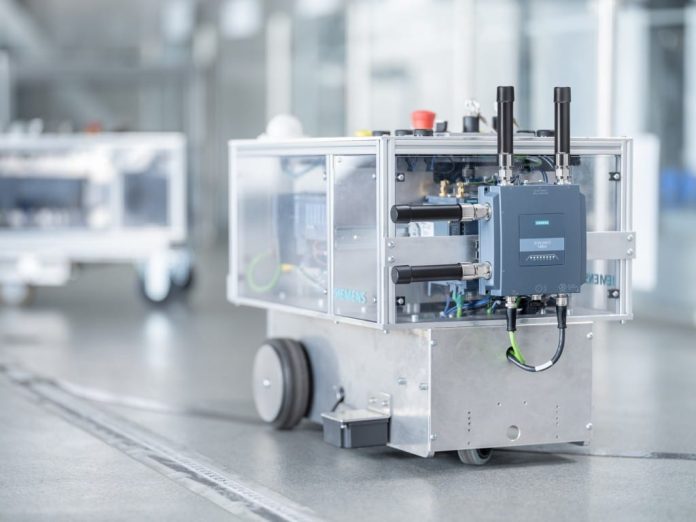Siemens has released its first ‘industrial 5G’ router, the Scalance MUM856-1, announced at the end of 2020, showcased at Hannover Messe in March, and trailed in these pages all through – as the Industry 4.0 market, busily deploying private 5G networks, has cried out for decent 5G hardware.
The Scalance MUM856-1 is notable because it represents a crucial 5G-play from the German industrial giant, which continues to develop its own private 5G bundle for factory deployments in the background, likely for a late-2022 release. Prototypes of Siemens’ 5G infrastructure for private networks are already in use at several sites, it said. The new unit plays with private 5G edge-networks too, it said.
But Siemens led on the device’s ability to integrate with public LTE and 5G, affording industrialists a means to connect remotely with factory operations. The company said in a statement: “In industry, in addition to the need for local wireless connectivity, there is increasing demand for remote access to machines and plants. In these cases, communication is usually over long distances.”
It said: “Public mobile networks can be used to access devices that are located at a considerable distance, for example in other countries. In addition, service technicians can connect to the machines they need to service via the mobile network while on the go. Public 5G networks are therefore an important element of remote access and remote servicing solutions.”
The router connects local industrial applications to public 5G NR, 4G-LTE, and 3G-UMTS networks, in order to remotely monitor and service plants, machines, control elements, and other industrial devices. It can also be integrated into private 5G networks. Like the just-announced round of IoT application processors from Qualcomm, as well as Qualcomm’s new 315 5G modem, the MUM856-1 supports Release 15 of the 5G standard.
Siemens said its 5G functionality, branded as ‘industrial 5G’, and IPv6 support ties in with Ethernet-based subnetworks and automation devices. The firm claims the unit supports throughput of (“up to”) 1,000 Mbps on the downlink and 500 Mbps on the uplink. The unit features an IP65-rated housing for use in heavy indoor and outdoor industrial environments, outside of control cabinets.
Siemens cited “future-oriented” applications such as mobile robots in manufacturing, autonomous vehicles in logistics or augmented reality applications for service technicians. It also emphasised its security functions, including an integrated firewall and VPN-based device authentication and transmission, to monitor data traffic and protect against unauthorized access. The device automatically switches to 4G or 3G when 5G is unavailable.
Siemens provided an update on its private 5G proposition – comprising a Siemens-developed 5G core, distributed unit, and radio units – citing testing at a Siemens plant in Amberg, and a new deployment at a plant in Karlsruhe and at the Deutsche Messe AG exhibition halls in Hanover (to go live in September). “Siemens is relying exclusively on its own independently developed products and solutions,” it said.
The first release version of the router has an EU radio license; other versions with different licenses are in preparation, it said. The Scalance MUM856-1 has been released in tandem with a new VPN platform manager, called SINEMA Remote Connect, allowing users to access remote plants or machines, even when integrated into other networks.

